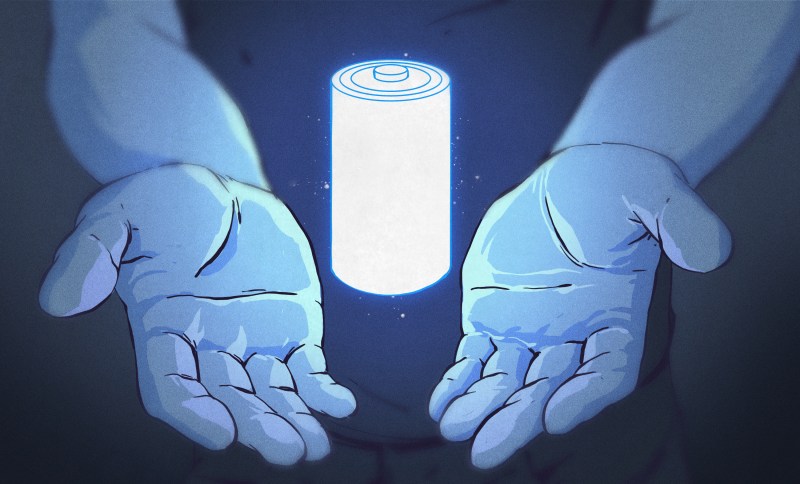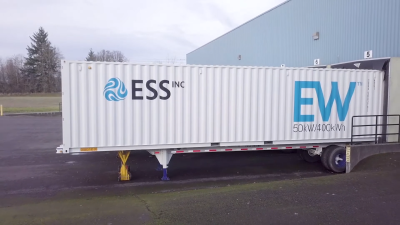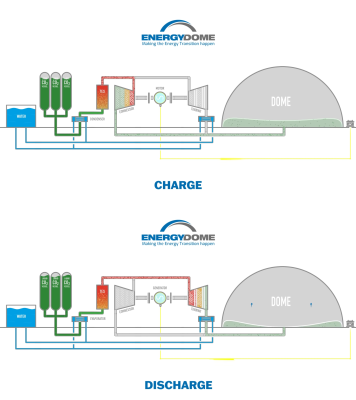
We’re all familiar with batteries. Whether we’re talking about disposable AAs in the TV remote, or giant facilities full of rechargeable cells to store power for the grid, they’re a part of our daily lives and well understood.
However, new technologies for storing energy are on the horizon for grid storage purposes, and they’re very different from the regular batteries we’re used to. These technologies are key to making the most out of renewable energy sources like solar and wind power that aren’t available all the time. Let’s take a look at some of these ideas, and how they radically change what we think of as a “battery.”
Iron Flow Batteries

Normally, the batteries we use consist of a metal or plastic case with some electrolyte inside, sandwiched between electrodes. Usually, the electrolyte is in a paste or gel form and for all intents and purposes, we think of batteries as a typically solid object, even if they’re gooey inside.
Iron flow batteries work in an altogether different fashion. They use liquid electrolyte that is pumped into a battery as needed to generate electricity. The electrolyte consists of iron ions in solution, typically in the form of aqueous solutions like iron chloride or iron sulfate.
Typical electrode materials are carbon for both the positive and negative sides, with the battery constructed as two half cells with a porous separator in between. As the battery is charged, the iron (II) ions are oxidized in the positive half-cell, giving up electrons to become iron (III) ions. In the negative half-cell, the iron (II) ions gain electrons to become iron (0), with the metallic iron plating on to the negative electrode itself. When the battery is discharged into a load, these reactions run in reverse, with the metal on the negative half-cell electrode returning to solution.

Iron flow batteries have the benefit that they scale. Larger tanks and larger cells can easily be built, which is ideal for grid applications where there is a desire to store many megawatt-hours of energy. Of further benefit is the cycle life of an iron flow battery, measured anywhere from 10,000 to 20,000 cycles. That’s an order of magnitude better than most lithium-ion cells, and gives iron flow batteries a working lifetime on the order of 10 to 20 years, or even longer.
The chemicals involved are also cheap and readily available – iron and its salts being easy to source almost anywhere in the world. There is little requirement for the fancy rare-earth metals that are key to the production of high-end lithium-ion cells. Plus, the chemicals used are also safe – there’s not really anything in a iron flow battery that can explode or catch fire like other technologies.
The iron flow battery does come with some drawbacks, though. The technology simply doesn’t have the power density of lithium-ion batteries, so more space is required to build a battery capable of delivering the same power. Additionally, due to the plating reaction on the negative electrode, the iron flow battery doesn’t scale as well as some other theoretical designs. Other flow batteries only require more electrolyte to keep producing energy, with the size of the electrodes unimportant in this regard. Furthermore, while the technology stores electrical energy directly in a chemical sense, iron flow batteries are still typically less efficient than hydroelectric pumped storage, assuming suitable land is available. Advanced hydroelectric storage methods can counter this requirement, however.
Companies are developing the technology for real-world applications today. Shipping-container sized flow batteries from companies like ESS are available with capacities up to 500 kWh, with power outputs high enough to power tens of houses over a 12 hour period. Stacking multiple units into a single installation scales the capacity as needed. They’re aimed at the so-called “long term” storage market, for storing energy on the order of 4 to 24 hours. This makes them ideal for use cases like storing energy during daily solar peaks for use in the dark night time hours.
Carbon Dioxide Storage

Carbon dioxide is all around us, as a key component of the atmosphere. It’s also a gas that can readily be stored as a liquid at ambient temperature, as long as you put it under enough pressure. In this form, it takes up far less space, and there’s energy to be gained in the phase transition, too. Energy Dome is a company that identified that this property could be useful, and has developed a storage system based on the prevalent gas.
To charge the carbon dioxide “battery,” energy is applied to compress the gaseous CO2 into a liquid. The heat generated in the compression process is stored in a thermal energy storage system. To extract power, the liquid CO2 is warmed from the formerly stored heat, and allowed to expand through a turbine, which generates power. The design uses CO2 in a sealed system. The energy is stored in the pressure applied to the CO2 and in the phase change, rather than in any chemical reaction. Thus, it’s not really a “battery,” per se, any more so than hydroelectric pumped storage, but it is an energy storage system.
The system has the benefit of being constructed from simple, well-understood equipment that is already readily available. There’s nothing radical about compressing gases nor expanding them through turbines, after all. Plus, there’s no need for expensive rare earth materials or even large amounts of copper wiring, as with lithium-ion battery storage solutions.
Energy Dome is already planning a commercial deployment in the US by 2024. It has already run tests at a scale of multiple megawatts, indicating the basic principle of the technology. The company has also secured an agreement to build a facility for the Italian energy company A2A, with a 200 MWh capacity and 20 MW power delivery.
Future Realities
The fact is that as grids around the world switch to more renewable energy solutions, there will be ever-greater demands to store that energy. Traditional solutions like hydroelectric pumped storage are still relevant, as are the major lithium-ion battery installations popping up all around the world.
However, different circumstances mean that other storage technologies can also find their own niche. In particular, those that rely on cheap, readily available materials will have an advantage, particularly given the geopolitical and supply chain issues faced today. Expect more new technologies to pop up in this space as storing renewable energy becomes a key part of our electricity grid in future.
Weird Energy Storage Solutions Could Help The Grid Go Renewable
Source: Manila Flash Report
0 Comments